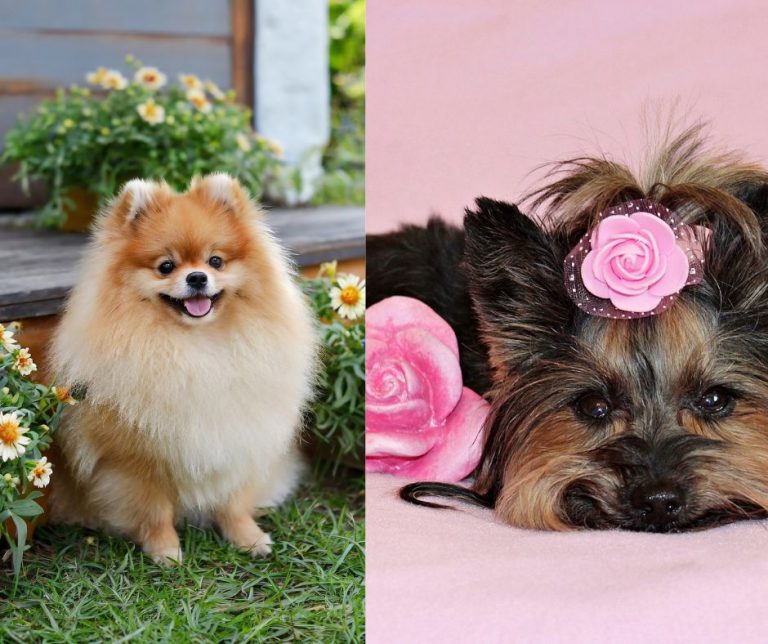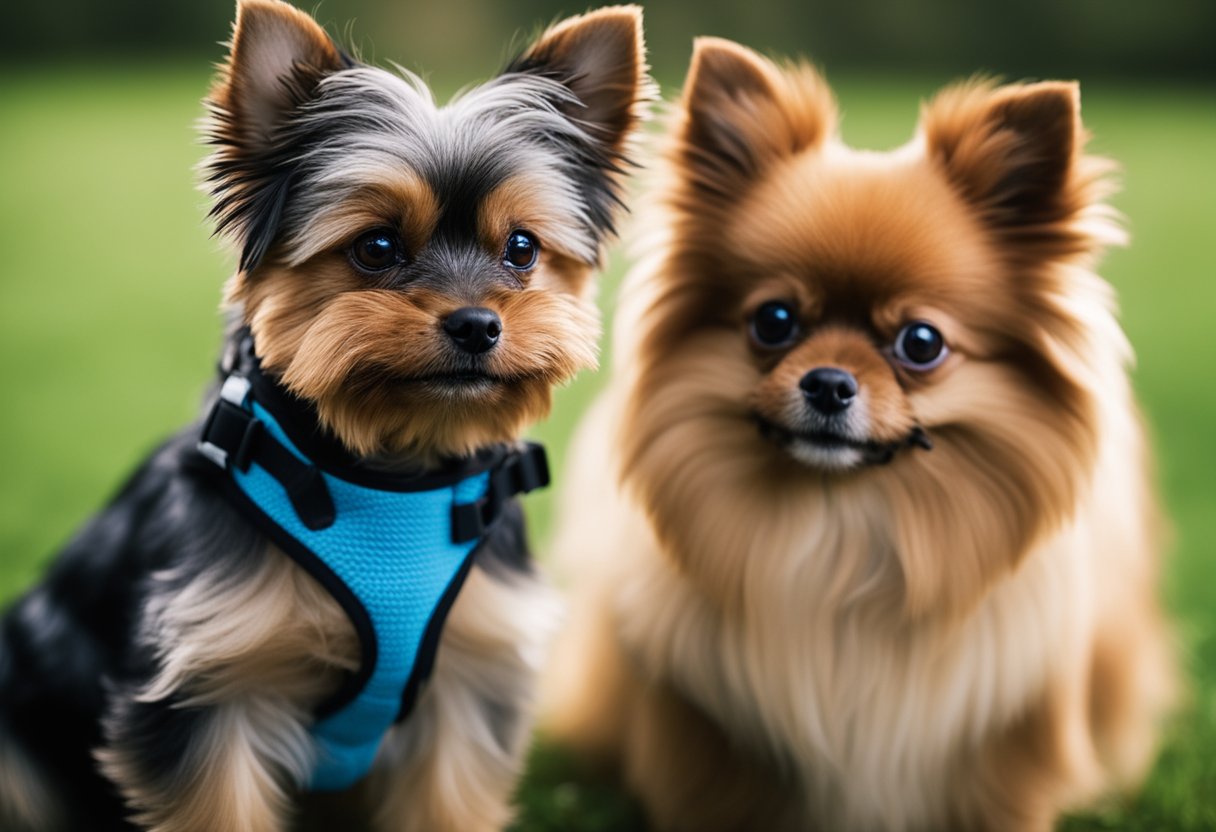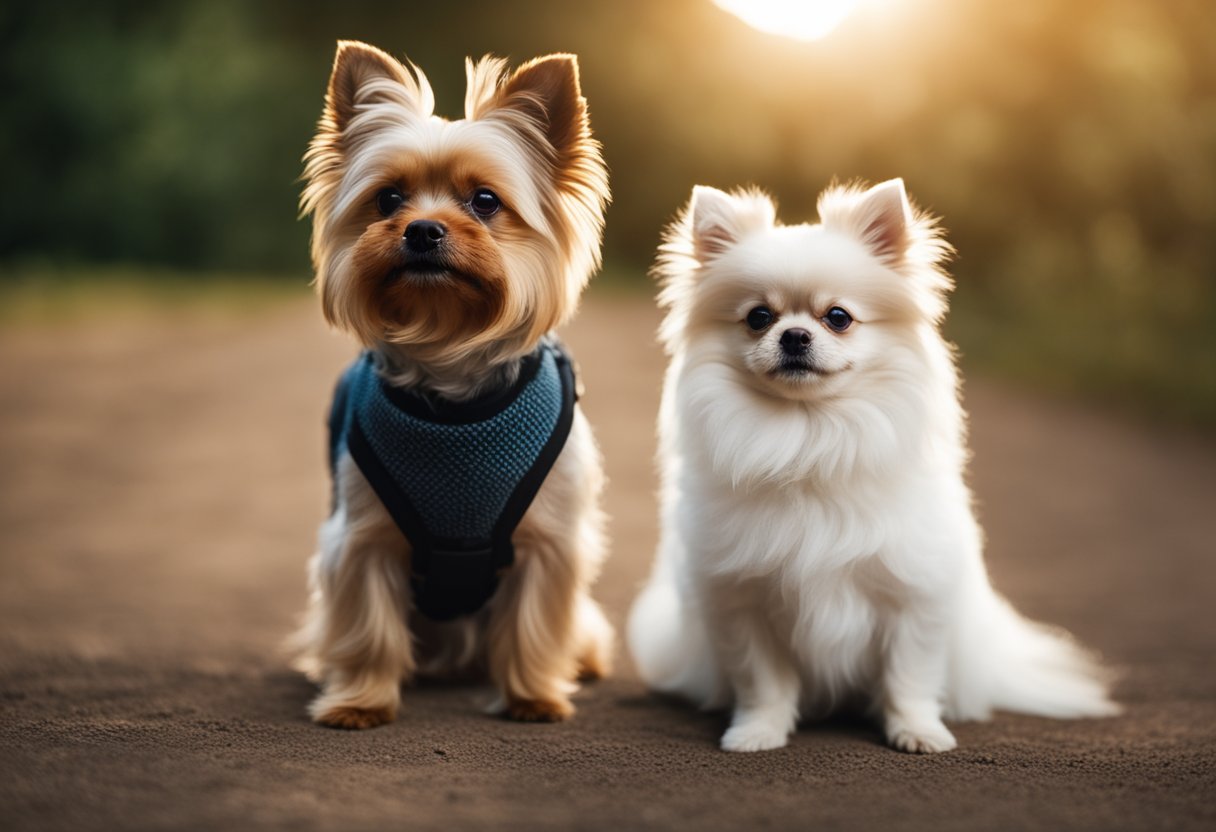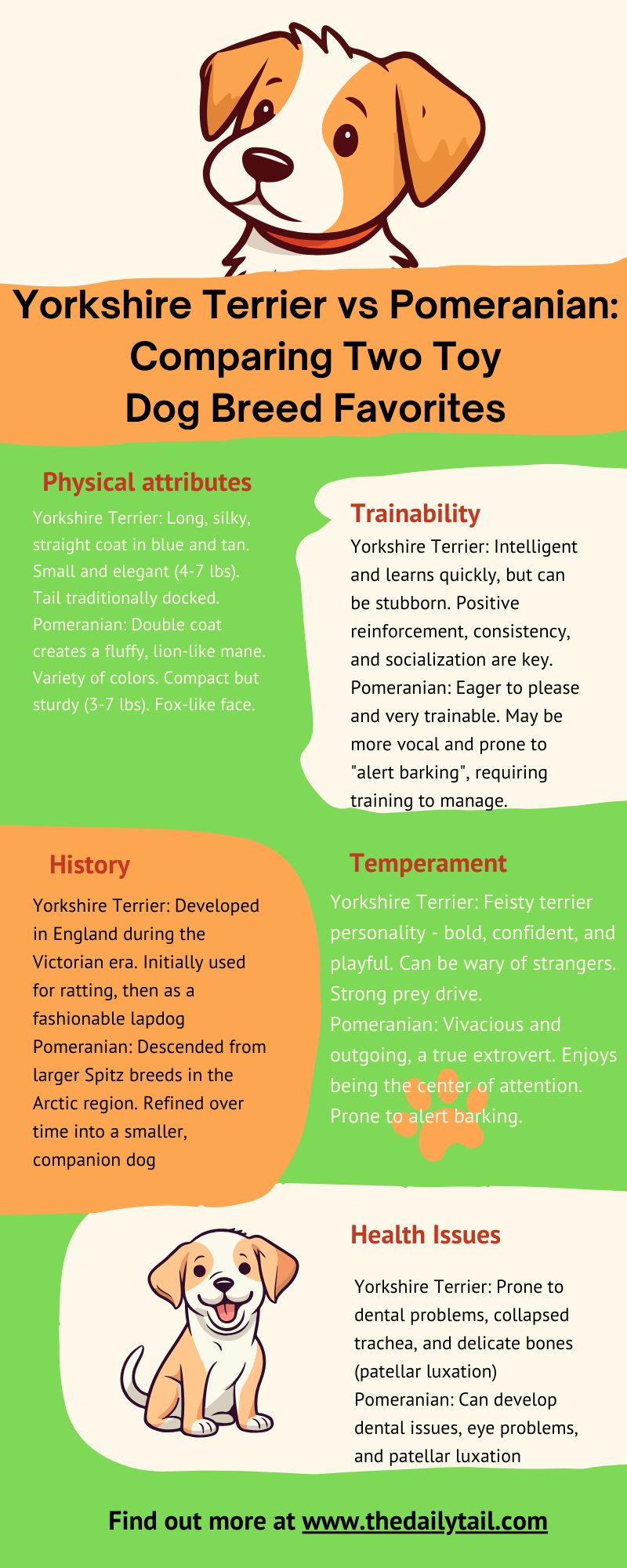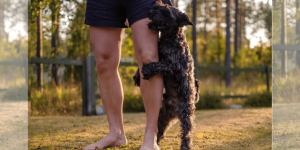As a seasoned dog owner, I know better than to underestimate a dog’s size. So, let’s dive into why the pint-sized Yorkie and Pom are heavyweights in personality.
Choosing the right family dog can be a delightful yet challenging decision, particularly when considering breeds as charming and personable as the Yorkshire Terrier and the Pomeranian. Both breeds are celebrated for their diminutive size and vivacious personalities, making them favored contenders for those residing in smaller living spaces or seeking a companionable lap dog.
Yorkshire Terriers, often referred to as Yorkies, stand out with their elegant, silky coats and are known for their affectionate and sprightly temperament. Their small stature doesn’t prevent them from being a feisty and bold member of the family, with a tendency to form strong bonds with their owners. On the other hand, Pomeranians boast a luxuriant fluff of fur and have a lively and inquisitive nature. Despite their tiny size, they carry a bold and confident demeanor, often unaware of their diminutive frame.
When delving into the nuances of each dog breed, potential dog owners should consider factors such as temperament, energy levels, and overall health. Both breeds share a similar life expectancy and have manageable energy levels that suit various lifestyles. However, their distinct personalities and care requirements can tip the scale for a family deciding which breed would blend seamlessly into their home and life.
I’ve tackled terriers, hounds, and everything in between. Yet, choosing between the Yorkie and the Pom still gave me pause! Here’s why. Let’s take a look into the Yorkshire Terrier vs Pomeranian dog breed comparison.
Breed Origins
The Yorkshire Terrier puppy and Pomeranian puppy both have distinct origins steeped in European history. Each breed’s development reflects the cultural and practical needs of their respective regions of origin.
Yorkshire Terrier Origin
The Yorkshire Terrier hails from the northern counties of England, with a strong heritage linked specifically to the region of Yorkshire. It emerged during the 19th century among working-class citizens who required a small and industrious terrier for catching rats and other vermin in mines and textile mills. This breed gained prominence as a fashionable companion for Victorian aristocrats later on.
Pomeranian Origin
Originally from the Pomerania region, which is now part of Poland and Germany, the Pomeranian was once much larger in size and used for herding livestock. Over time, this breed was miniaturized to the smaller, companion-sized dog we know today. The Pomeranian shares its lineage with other Spitz-type dogs and is closely related to the German Spitz.
Physical Characteristics
In comparing Yorkshire Terrier vs Pomeranian, distinct differences in size, coat, and overall appearance are evident. These breeds exhibit unique physical traits that cater to a variety of preferences in potential owners.
Size and Weight
- Yorkshire Terrier:
- Height: 7-8 inches
- Weight: 2-7 pounds
- Pomeranian:
- Height: 6-7 inches
- Weight: 3-7 pounds
Yorkshire Terriers and Pomeranians are small in stature, with the Yorkie generally standing slightly taller. Their weights are comparable, making both suitable for individuals seeking a lightweight companion. Yet, as with all small dog breeds, there is always an even smaller version. In this case, a Teacup Yorkie and Teacup Pomeranian.
Coat and Color
- Yorkshire Terrier:
- Coat: Long, silky
- Color: Blue and tan, often with black intermingled
- Pomeranian:
- Coat: Fluffy double coat
- Color: Wide range including red, orange, cream, black, and white
Yorkshire Terriers sport a fine, glossy coat that is often described as silky, contrasting with Pomeranians’ thick, fluffy double coat. Both breeds require regular grooming but in different ways due to their coat types. The Pomeranian’s luxurious coat comes in a broader color palette, including vibrant reds and oranges, as well as softer hues like cream and white.
Breed Appearance Comparison
Yorkshire Terriers and Pomeranians, while both toy breeds, present noticeable differences in appearance. The Yorkshire Terrier’s signature long hair gives them an elegant look, whereas the Pomeranian’s fluffy double coat offers a more rounded, plump silhouette. The Yorkshire Terrier’s coat can be found in a mix of blue and tan, which can include varying degrees of black, creating a unique color blend for each individual dog. In contrast, Pomeranians boast a spectrum of colors ranging from bold reds and oranges to more subdued creams and whites, sometimes accented with darker shades, providing them with a striking variety in appearance.
The American Kennel Club recognizes both breeds and has set the breed standard for both canines. Let’s take a look.
Temperament and Personality
When choosing between a Yorkshire Terrier and a Pomeranian, temperament and personality are crucial factors to consider. Each breed exhibits distinctive traits that may align with your lifestyle and preferences.Yorkshire Terrier Temperament
Yorkshire Terriers, often referred to as Yorkies, possess a confident and affectionate personality. Despite their small size, they are bold and independent, often carrying themselves with an almost regal presence. Their loyalty to their owners is deep-seated, making them excellent companions. These dogs can be quite vocal, with a propensity for barking, which can be curbed with proper training. They sometimes exhibit a stubborn streak but are generally seen as highly intelligent, which can both challenge and entertain their owners.
- Affectionate: Loyal and loving towards their owners
- Energy Level: High; often active and spirited
- Friendly: Can be friendly when socialized properly, but may be reserved with strangers
- With Other Dogs: Their confident nature can sometimes lead to feistiness with other dogs
Pomeranian Temperament
Pomeranians are known for their playful and friendly demeanor, full of life and excitement. They may be small but have an expansively bold and confident attitude, often unaware of their diminutive size. Similar to Yorkies, Pomeranians can form strong bonds with their owners and are known to be quite affectionate. They can sometimes be perceived as aggressive due to their loud barking, although this is often simply a display of their enthusiasm and alertness. However, they are intelligent and, with consistent training, can manage their vocal tendencies well.
- Affectionate: Enjoys close contact with their owners
- Energy Level: High; energetic and lively
- Friendly: Generally warm to both owners and strangers, but may be reserved at first
- With Other Dogs: Can be friendly, but their confidence may lead to dominance issues with other dogs
Common Temperamental Traits
Yorkshire Terriers and Pomeranians share a number of temperamental traits, often displaying a feisty energy that belies their small size. Both breeds tend to be very loyal and affectionate with their favorite humans and can become devoted companions. As smaller dog breeds, they are adaptable to various living situations but do require adequate mental stimulation and exercise to prevent problematic behaviors. Socialization from a young age is important for these breeds to ensure they are well-adjusted and friendly in diverse settings. Their intelligence means they can be trained effectively, but this same trait can sometimes lead to stubbornness in both Yorkshire Terriers and Pomeranians.
Care and Grooming
Proper care and grooming are essential for maintaining the health and happiness of both Yorkshire Terriers and Pomeranians. These breeds have specific needs regarding exercise, grooming, and health that owners should be attentive to.
Exercise Needs
Yorkshire Terriers and Pomeranians possess a moderate level of energy and require regular exercise to stay healthy. Both breeds benefit from daily walks and playtime.
- Yorkshire Terriers: Up to 30 minutes/day of exercise
- Pomeranians: 20-30 minutes/day of exercise
Exercise also helps mitigate potential behavioral issues and keeps their minds stimulated.
Grooming Requirements
The grooming needs of Yorkshire Terriers and Pomeranians are significant, due to their coats requiring regular maintenance.
- Yorkshire Terriers: They have a long, silky coat that needs daily brushing to prevent matting and tangling
- Pomeranians: They sport a thick double coat that necessitates brushing several times a week to manage shedding and avoid matting
Owners should be prepared for the grooming commitment to keep these breeds’ fur in good condition.
Health Considerations
Both the Yorkshire Terrier and Pomeranian breeds are susceptible to certain health issues that can be mitigated or managed with proper care.
- Yorkshire Terriers may have concerns such as collapsed trachea, hypoglycemia, and patellar luxation. Regular vet check-ups are crucial
- Pomeranians can be prone to issues like progressive retinal atrophy, epilepsy, and patellar luxation as well. Monitoring their health closely and providing preventative care is key
Owners should watch for signs of heatstroke in both breeds due to their small size and susceptibility to temperature extremes. Regular health check-ups are important to catch any early signs of these conditions.
Living Environment
Yorkshire Terriers and Pomeranians are both small-sized breeds that can adapt well to various living environments, including apartments. Their compact size and personality traits affect how they integrate with family life and their surrounding spaces.Adapting to Living Spaces
Yorkshire Terriers, affectionately known as Yorkies, are well-suited for apartment living. They don’t require a large space to roam and are generally content in smaller living areas. Regular exercise and mental stimulation are, however, important to keep them happy. On the other hand, Pomeranians also thrive in apartments due to their small stature. They too need adequate playtime and interaction as they are lively and inquisitive by nature.
Both breeds can trigger allergies as they are not hypoallergenic. Routine grooming can help to minimize allergens but is an important consideration for potential owners with sensitivity to pet dander.
Compatibility with Families
When considering children, both breeds can adapt to living with families but may be better suited to homes with older children who understand how to handle small dogs carefully. Yorkshire Terriers and Pomeranians are not known for being particularly patient with small children and should always be supervised during interactions.
Despite their size, both breeds exhibit a tendency to take on the role of guarding. They are often alert and can be protective of their homes. However, potential owners should note that their guarding ability is more vocal than physical due to their small size.
Careful consideration of the living environment is essential when choosing between a Yorkshire Terrier and a Pomeranian, particularly for families and individuals living in apartments. The breeds’ adaptability and exercise needs are important factors in ensuring a harmonious home life.
Training and Socialization
When it comes to training and socialization of Yorkshire Terriers and Pomeranians, pet owners will find that both breeds respond well to consistent and positive approaches. Due to their intelligence levels, they require regular mental stimulation and enjoy learning new things, making them quite trainable.
Intelligence and Trainability
Yorkshire Terriers (Yorkies): They display high levels of intelligence, making them relatively easy to train when consistent methods are applied. To keep their minds active and prevent boredom, Yorkies benefit from:
- Challenging Games: Such as puzzle toys that foster problem-solving skills
- Obedience Training: Critical to instill discipline and strengthen their learning abilities
Pomeranians: Equally intelligent and capable of learning quickly. Mental stimulation is a must for this breed, and they thrive on:
- Positive Reinforcement: Like treats or praise to encourage good behavior during training
- Variety in Training Routines: To maintain their interest and keep training sessions engaging
Socialization with Humans and Pets
Yorkshire Terriers: They often form strong bonds with their families but can be overprotective at times. Early socialization is key and includes:
- Exposure to Different People: To develop a well-rounded temperament
- Interaction with Other Dogs: To learn appropriate social behavior
Pomeranians: Social creatures by nature, they can be quite friendly but may show wariness around strangers. They benefit from:
- Regular Social Encounters: Which help to build their confidence and sociability
- Supervised Playdates: Particularly important for socializing with larger dogs due to their small size
Breed-Specific Concerns
When selecting a family dog, it is crucial to be aware of breed-specific concerns that may impact the dog’s health and behavior. Each breed carries its unique predispositions that potential owners should consider. Usually, little dog breeds live longer. But that doesn’t mean they do not suffer from health risks.
Common Health Issues
Yorkshire Terriers and Pomeranians share some health issues while also exhibiting concerns exclusive to their breeds. Yorkshire Terriers, for instance, are prone to:
- Patellar Luxation: Dislocation of the kneecap, which can result in lameness or discomfort
- Progressive Retinal Atrophy: A degenerative eye disorder that can lead to blindness
- Collapsed Trachea: A condition that causes a narrowing of the windpipe, leading to breathing difficulties
In contrast, Pomeranians often face:
- Epilepsy: A neurological condition that can cause seizures
- Heatstroke: Due to their thick coats, they can overheat quickly in warm environments
- Hypoglycemia: Low blood sugar levels that can cause weakness and, in severe cases, loss of consciousness
Both breeds can potentially suffer from dental issues due to their smaller jaw size.
Behavioral Tendencies
Behaviorally, Yorkshire Terriers and Pomeranians can exhibit distinct temperaments. Yorkshire Terriers, or Yorkies, are known for their:
- Aggression: While they can be affectionate, they may show aggression towards other animals and strangers if not properly socialized
- Hunting Instincts: They have a heritage as ratters, and their hunting instincts can still manifest in their behavior
Pomeranians, however, are:
- Sociable: They are generally friendly and active but can become yappy if not trained appropriately
- Guarding Tendencies: Despite their small size, they can be protective and may bark at unfamiliar sounds or intruders
Understanding these breed-specific proclivities is integral to ensuring a harmonious household and the well-being of the dog.
Choosing Between Breeds
When selecting a dog breed, potential owners must consider how a pet fits into their current lifestyle, including living space, activity level, and family dynamics.Lifestyle Considerations
Living Space: The Yorkshire Terrier puppy and Pomeranian puppy are a small dog breed suitable for apartment living, but they have different energy levels and exercise needs. Pomeranians often require more frequent bursts of activity to expend their high energy. In contrast, Yorkshire Terriers have a moderate energy level but will still appreciate daily exercise.
Families and Children: Both breeds can adapt to homes with children if socialized early. However, due to their small size, they are better suited for families with older children who understand how to interact gently with small pets.
Watchdog Potential: Despite their small stature, Yorkshire Terriers and Pomeranians are alert and can be good watchdogs, notifying their owners of unfamiliar activity.
Breed Comparison for Potential Owners
Exercise Needs: Yorkshire Terriers generally need less intense activity than Pomeranians. A Yorkshire Terrier requires regular walks and some playtime, while a Pomeranian will benefit from additional exercise and mental stimulation to manage its higher energy levels.
Breed Similarities: Both toy dog breeds share traits such as their compact size and sociability, making them companions who thrive on interaction with their owners.
Comparison:
- Exercise: Pomeranians often demand more exercise and stimulation than Yorkshire Terriers
- Watchdog Ability: Both serve well as alert dogs but differ in temperament; Yorkshire Terriers tend to be more vocal
- Suitability with Children: Both can be good with children if raised with them, though care must be taken due to their small sizes
- Adaptability to Apartments: Both breeds are well-suited to apartment living but have different needs for space and activity

